Related Research Articles

Henry George Carey Jr. was an American actor. He appeared in more than 90 films, including several John Ford Westerns, as well as numerous television series.

Out West is a 1918 American two-reel silent comedy film, a satire on contemporary Westerns, starring Roscoe "Fatty" Arbuckle, Buster Keaton, and Al St. John. It was the first of Arbuckle's "Comique" films to be filmed on the West Coast, the previous five having been filmed in and around New York City. The idea for the story came from Natalie Talmadge, who was later to become Keaton's first wife. The film contains racial stereotypes and attitudes, including a scene in which a gang of rowdy cowboys make a black man, played by Ernie Morrison Sr., dance by shooting at his feet.
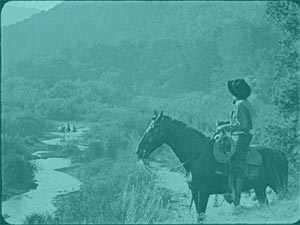
Bucking Broadway is a 1917 American silent Western film directed by John Ford, probably his sixth feature film. Long thought to be lost, along with about 60 of Ford's 70 silent films, it was found in 2002 in the archives of the CNC. It was subsequently restored and digitized and is available on the Criterion Blu-Ray of John Ford's Stagecoach.
Vester Pegg was an American actor of the silent film era. He appeared in 140 films between 1912 and 1941, mainly Westerns. He was born in Appleton City, Missouri and died in Los Angeles, California.
Goin' Straight is a 1917 American silent film featuring Harry Carey and released by Universal Pictures.

The Fighting Gringo is a 1917 American silent Western film directed by Fred Kelsey and featuring Harry Carey. Its survival status is unknown.

A 44-Calibre Mystery is a 1917 American short Western film, featuring Harry Carey. Carey plays the role of Sheriff Cheyenne Harry. He saves Kitty Flanders from Pete McGuire and takes her safely home. McGuire hides in a shack on Mr. Flanders' stake and Harry's deputy is shot dead, apparently by Mr. Flanders. McGuire offers to keep quiet about the murder if Flanders gives him half a stake and his daughter's hand in marriage. Mr. Flanders confesses his crime to Sheriff Harry and learns that he is innocent. Sheriff Harry notices McGuire's gun and accuses him of the crime, but they are killed as they try to escape. The film concludes as Kitty Flanders confesses her love to Sheriff Cheyenne as she bandages his wounds from the fight.

Cheyenne's Pal is a 1917 American silent Western film directed by John Ford and featuring Harry Carey. The film is considered to be lost.

Straight Shooting is a 1917 American silent Western film directed by John Ford and featuring Harry Carey. Prints of this film survive in the International Museum of Photography and Film at George Eastman House. Like many American films of the time, Straight Shooting was subject to cuts by city and state film censorship boards. The Chicago Board of Censors refused to issue a permit for this film as submitted as it consists of detailed portrayal of murder and outlawry.

The Secret Man is a 1917 American silent Western film, directed by John Ford and featuring Harry Carey. Two of the five reels of the film survive at the Library of Congress film archive.

A Marked Man is a 1917 American silent Western film directed by John Ford and featuring Harry Carey. It is considered to be a lost film.
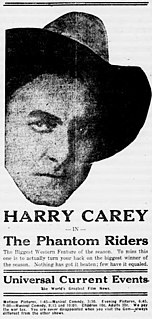
The Phantom Riders is a 1918 silent American Western film directed by John Ford and featuring Harry Carey. The film is considered to be lost.

Thieves' Gold is a 1918 American Western film directed by John Ford and featuring Harry Carey. It is considered to be a lost film.
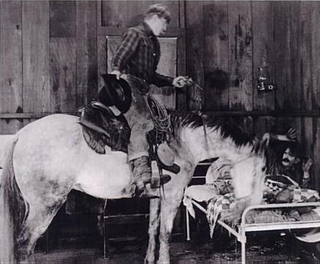
Hell Bent is a 1918 American Western film directed by John Ford and featuring Harry Carey. A print of the film exists in the Czechoslovak Film Archive.
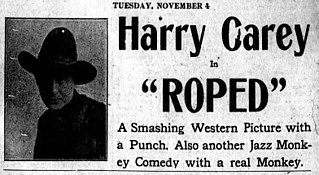
Roped was a 1919 American Western-comedy film directed by John Ford and featuring Harry Carey. The film is considered to be lost. Roped is one of at least 25 films in which director John Ford and actor Harry Carey collaborated on between the years of 1917 and 1921. Ford saw Carry as a mentor and their worked on the story ideas for several of their films together.
A Fight for Love was a 1919 American Western film directed by John Ford and featuring Harry Carey. The film is considered to be lost.

Bare Fists is a 1919 American Western film directed by John Ford and featuring Harry Carey. It is considered to be a lost film.

Riders of Vengeance is a 1919 American Western film directed by John Ford and featuring Harry Carey. The film is considered to be lost.

Ace of the Saddle is a 1919 American silent Western film directed by John Ford and featuring Harry Carey. The film is considered to be lost.
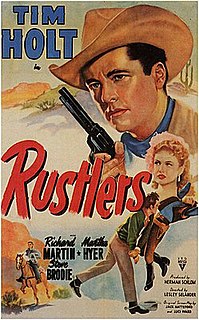
Rustlers is a 1949 American Western directed by Lesley Selander. The film is a Tim Holt B Western about a group of Arizona ranchers intent on stopping a gang of cattle rustlers.
References
- ↑ Kuhn, Annette; Westwell, Guy (December 20, 2012). "Two-reeler". A Dictionary of Film Studies. Oxford University Press. doi:10.1093/acref/9780199587261.001.0001. ISBN 978-0-19-958726-1 . Retrieved April 5, 2020.
- ↑ "Silent Era : Progressive Silent Film List". www.silentera.com. Retrieved April 4, 2020.
- ↑ Chalmers Publishing Company (1917). Moving Picture World (Jan 1917). New York The Museum of Modern Art Library. New York, Chalmers Publishing Company.